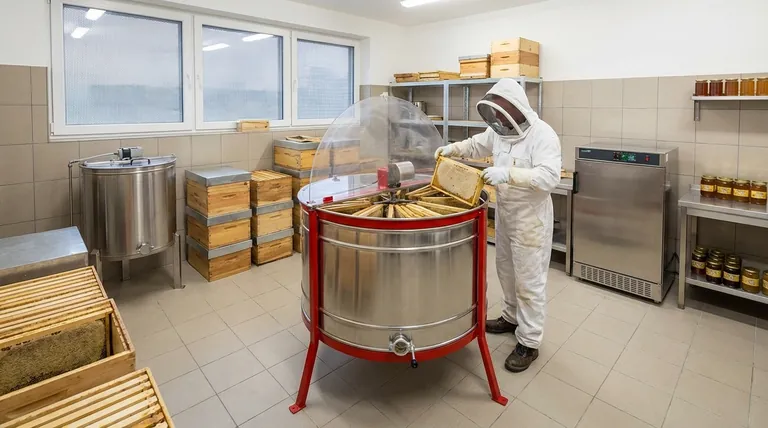A successful honey extraction location is primarily defined by three critical factors: it must be dry, completely isolated from bees, and have a controllable temperature suited to your specific extraction method. These elements are non-negotiable for ensuring honey quality, process efficiency, and your own safety.
The ideal extraction space is not merely a matter of convenience; it is a controlled environment. Your choice of location directly dictates the final quality of the honey, the ease of the extraction process, and your ability to work without interference from your bees.

The Foundational Requirements for Any Extraction Space
Before considering temperature or specific methods, two environmental factors must be addressed. These form the baseline for any successful and safe honey harvest.
Ensuring Bee-Proof Security
The scent of honey is a powerful attractant for bees. A single entry point can quickly lead to a "robbing frenzy," where bees from your own or neighboring hives attempt to steal the honey, creating a chaotic and potentially dangerous situation.
Your location must be completely sealed. This means ensuring all windows are closed and screened, doors are kept shut, and there are no significant gaps that would allow bees to enter.
Maintaining a Dry Environment
Honey is hygroscopic, meaning it naturally absorbs moisture from the surrounding air. Extracting in a humid location can increase the honey's water content above the safe threshold of ~18%.
Excess moisture can lead to fermentation and spoilage, ruining your entire harvest. A dry location is therefore essential for preserving the quality and shelf-life of your final product.
The Critical Role of Temperature
Temperature is the variable that you will adjust based on the type of honey product you intend to create. The state of the wax and the viscosity of the honey are directly managed by the ambient temperature.
Warmth for Liquid Honey Extraction
For methods that involve separating honey from the comb, such as using a centrifugal spinner or the "crush and strain" technique, warmth is your greatest ally.
A warm room (and consequently, warm honey) significantly reduces the honey's viscosity, allowing it to flow much more freely. This makes the extraction process faster, easier, and yields more honey from the combs.
Coolness for Cut-Comb Production
The goal of "cut-comb" honey is to produce perfect, intact sections of sealed honeycomb for consumption. In this case, warmth is detrimental.
Cooler conditions keep the wax comb firm and less delicate. This allows for clean, precise cuts without the comb becoming floppy or tearing, which is essential for creating a premium, visually appealing product.
Understanding the Trade-offs
The theoretically "perfect" extraction space often doesn't exist for hobbyists. Most locations involve a compromise.
The Kitchen Dilemma
A home kitchen is a common choice due to its clean surfaces and accessibility. However, it can be very difficult to make it completely bee-proof, and the potential for a sticky mess is high.
The Garage or Shed Challenge
A garage or shed is often easier to isolate from bees and contains any mess. The primary challenge here is environmental control; these spaces can be prone to dust, high humidity, or lack the means for temperature regulation.
The Impact of Equipment
Your chosen method also dictates space needs. A large radial extractor requires significant floor space and a solid surface, while a simple crush-and-strain setup can be done on a tabletop, influencing which location is most practical.
Making the Right Choice for Your Goal
Your ideal location is the one that best supports your primary harvesting objective.
- If your primary focus is extracting liquid honey: Prioritize a warm, bee-proof room to ensure the honey flows easily and you maximize your yield.
- If your primary focus is producing premium cut-comb: Choose a cooler, dry, and secure space to keep the wax firm for clean, professional-looking cuts.
- If you are a small-scale hobbyist with limited space: Focus first on making your chosen location absolutely bee-proof, as this is the most critical safety and operational factor.
By thoughtfully preparing your extraction space, you transform a potentially chaotic task into a controlled and rewarding part of the beekeeping process.
Summary Table:
| Key Consideration | Primary Goal | Ideal Condition |
|---|---|---|
| Bee-Proof Security | Prevent robbing & ensure safety | Completely sealed room (windows, doors, gaps) |
| Dry Environment | Preserve honey quality & prevent spoilage | Low humidity to keep water content below ~18% |
| Temperature Control | Optimize for extraction method | Warm for liquid honey; Cool for cut-comb honey |
Ready to optimize your honey harvest?
For commercial apiaries and distributors, the right equipment is just as critical as the right location. HONESTBEE supplies the durable, high-performance beekeeping supplies and extraction equipment you need to operate efficiently at scale.
From commercial-grade extractors to protective gear, our wholesale-focused operations are designed to support your business.
Contact HONESTBEE today to discuss your equipment needs and ensure your entire extraction process is a success.
Visual Guide

Related Products
- HONESTBEE 72 Frame Industrial Electric Honey Extractor for Beekeeping
- HONESTBEE 3-Frame Manual Acrylic Honey Extractor
- electric honey extractor honey centrifuge 3 frame honey extractor stainless steel honey frame extractor
- 2 Frame Stainless Steel Manual Honey Spinner Extractor for Beekeeping
- 40 Frame Commercial Electric Honey Extractor for Beekeeping
People Also Ask
- Why do beekeepers have to lift a lot of weight at the end of a growing season? The Reward of a Heavy Harvest
- Why is preserving honeycomb integrity important, and how do automated extractors help? Boost Hive Health & Honey Yields
- What is the energy consumption like for automatic honey extractors? Maximize Your Harvest Efficiency
- What should a beekeeper do after extracting honey from supers? A Guide to Harvest Management
- What are the advantages of automated honey extractors in terms of time efficiency? Boost Your Harvest Speed



















